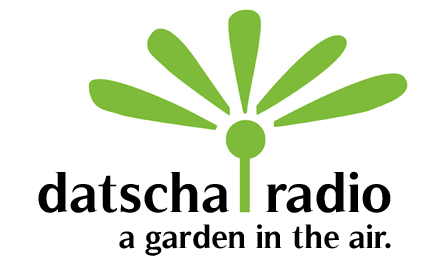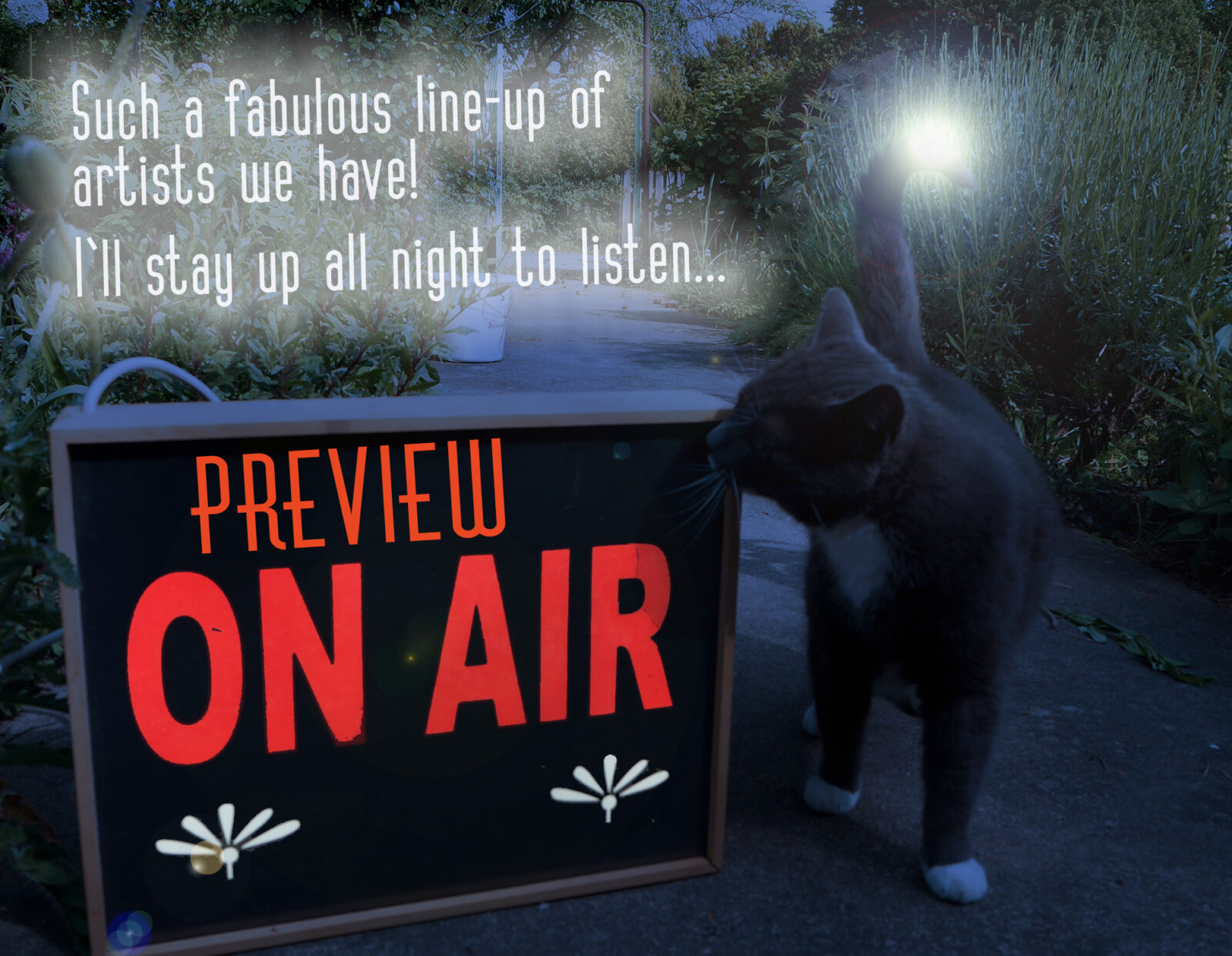
What is a ritual, what is a ceremony? Does the garden have its own secret rituals that go by unobserved, that are beyond the capabilities of human sensory perception? And what about the energies that are constantly being used up in pursuits of work and play: Do we ever express our thanks to them?
Datscha Radio’s third iteration of NightGardening began with a lullaby by the artist Ela Spalding. Instead of singing or using words, Ela’s lullabies are softly hummed, minimalistic tunes in which the pauses are as important as the fragmented melodies. Ela Spalding is a member of the transdisciplinary group Archipel e.V, and although she was not present for the first moments of the broadcast, she had sent a selection of her “Sundown songs”. And so, from then on, our programme was interspersed with strangely soothing nonverbal sequences, which kept bridging the states of being awake, asleep, and dreaming… just as they bridged the transitions of our programme, traveling from sunset through to the depths of this autumn night.

As for the weather, by the way, we were extremely lucky: Before sunset there was sun, and the temperatures stayed surprisingly mild. Also, plenty of food had been prepared by the painter Mathias Deutsch, who had tended the kitchen from the afternoon on.

Our opening introduction was followed by a bit of sage magic: Niki Matita, still suffering from a bad cold, had to stay at home. The burning of a twig of sage, accompanied by an ancient cough spell helped, or so it was hoped by the radio team Kate Donovan, Helen Thein and Gabi Schaffner. Meanwhile the fire bin, thoroughly fed with some dead branches from the cherry tree, spat fire and sparks under the darkening sky.
Be it either because of or despite the omnipresence of magical thinking in our everyday lives, it becomes increasingly difficult to create new meaningful rituals, or, to view them from a non-human perspective. Kate Donovan’s ritual of gratitude for the energies necessary for many human endeavours made its point there, just as Helen Thein’s questions about the possible ritualistic behaviours among the plants of the garden did.

Datscha Radio’s open call had sprouted a very fine selection of compositions by international artists, and we began with an excerpt of Julia Drouhin’s sound performance “Entretiens avec mes interieurs” (later on played in full) and Koho Jaripekka’s “Piano/FM Radio/Loop”.

Then the artist and curator Brane Zorman stepped into the garden. He told us about his current compositional research for the Slovene Arts & Culture Residency in Berlin, and his work with Radio Cona in Ljubljana. Meanwhile, the “Blue Flower of Death“ resided on the table between us and awaited its turn to be introduced to our listening audience, and to Brane, who was eventually allowed to touch the plant with a rubber glove on.

Aconitum napellus (here in the late-blooming form of the carmichaelii variant) is probably the most poisonous plant in Middle Europe. According to the myth, it grew from the spit of the hellhound Zerberus, and even in pre-Roman times the “Aconit” powder extracted from the root was used as a reliable poison for hunting and murder. It also helps to retransform werewolves, hence the name “Wolves Bane”. Nonetheless, its glorious blossom beautified the winter garden studio. As most of our talks were held in English, Helen took care of their German translations.
For this evening (and ensuring night), our listeners were indeed a mixed crowd. Datscha Radio’s Nightgardening date coincided with the World Day of Feminist Radio, which we consequently joined with our programme, and even from 7pm on, Sound Art Radio in Devon, UK, was following our programme in excerpts. (A complete list of re-broadcasting radio stations will follow at the end of this resume.)

Niki Matita had pre-produced a sound walk, walking with Fiep the cat along the garden plots of a ship, so we played “Nachts im Garten der MS Sputnik”, which was followed by Joan Schuman’s superb piece “Ligature”, about two conjoined twins whispering themselves to sleep. Mariah Blue’s “Hypnagogia” followed, which dealt with the auditory hallucinations that occur while falling asleep.
At around 9pm, the Finnish artist and performer Niina Lehtonen-Braun arrived, together with Ela Spalding herself and Niko de Paula Lefort, who carried a big suitcase with him.
“Iltakahvit with Niina Nokkonen“ proved to be a delightful on-the-fly lecture involving Finnish lullabies, mother’s and grandmother’s advice and sayings, nightly bedtime rituals, and of course the art of brewing coffee – with and without homemade brandy. From now on we’ll be sure never to go to bed without a handkerchief… and always to wear clean underwear and the most beautiful nightgown!
Our programme continued with another performance recording, this time by Martyna Posnanska: “Requiem for a Fly”. And a new format was ceremonially introduced. In “Breaking Nuts“, the garden’s hazelnuts were cracked in order to find out if they contained stories. Most of them did!
Kate Donovan used a walkie-talkie for her reading performance outside the Datscha, which featured a text by Rikki Ducornet about nightwalking, looking, imagining… “Once when the moon’s full face illuminated the paths of sand I entertained this reverie: I imagined a planet where languages grow as spontaneously as crystals; I pretended that the fossils – so perfectly round – were the seeds of new moons.”
Niko’s suitcase turned out to be a Eurorack modular synthesizer. He described his performance “Aurality“ as a live rehearsal; he has just started developing and practicing the compositions for this series, which will be played later in November in “Acud Macht Neu” in Berlin.
From there, we went straight from one Archipel member to another: Ela Spalding joined us live on air. She introduced her work “Ocaso / Sundown”. Ela performed a special ‘bedtime routine’ with us, reading a story (about thinking of Berlin in a deep-time context) and singing a lullaby live.
At 11:30 pm, the artist and musician Ansgar Wilken unwrapped his percussion items from a towel and spread them on the floor. Among them were a dust pan, a metal ashtray, a silver chain, tiny gongs, marbles in a bowl, and several items made from wire, rubber or other things. His percussive concert led us into “The secret Rhythm of Tulpen und Narzissen“. At an incredible speed, the objects on the floor were drummed, strummed and stroked, plucked and picked, arranged and rearranged into ever-changing patterns that could be heard and seen. Our following talk dealt with morning rituals – from the unchanging sequence of drying the body after a shower, to the catastrophe of missing milk in morning coffee.
Outside, still more guests had arrived, and were enjoying food and drinks at the table. Podcaster Laura Lukitsch had come to record material for her next radio show. Artist Marold Langer-Philippsen held his recording gear in his hand, directing it towards the hissing flames of the fire bin in preparation for his upcoming performance in the wee morning hours.
Midnight had come. “The Beetles’ Harvest Supper“ saw the artist and scientist Kat Austen dealing with a bowl of flour, some milk, an egg, spoons filled with baking powder. Drawing on human harvest rituals to ensure a good harvest for the next year, Kat carried out the “Rite of Future Beetles”, to ensure an abundant ecosystem for insects next year. This involved baking beetle corn spirits, summoning the season’s remaining beetles with a bright vivid BANG!, and sharing the corn spirits with them at midnight.
Niki Matita had prepared two other pre-productions for us to play in her absence: “Knöpfrunde“, a short radio play by Hermann Bohlen, and “Mitternächtliche Klangreise” (Midnight sound journey), a performance by the Berlin musician, shaman and healer Zelda Panda. More compositions from the open call found their way onto the air waves, including two works by Chelidon Frame, one by Alex Head (curator of the Berlin radio project “Networked Independence”) and Ana Berkenhoff’s “Beastjetzt“. “After the moonrise“ and “Low rise“ framed Ms Schaffner’s presentation of “Singing Fires“, which was a compilation of archived field recording files recorded by the music anthropologist Sisukas Poronainen on the occasion of a ceremonial gathering at Pauanne, Kokkola, in West-Finland in 2004.
Mainly sung by a fire, the ceremonial songs contained lyrics from the Kalevala, a cosmogonic myth in verses, compiled by Elias Lönnerot in 1835. Although recorded in the 21st century, the atmosphere of the songs and runos (magic spells) felt very ancient.
A new round of “Breaking Nuts“ with Helen Thein, Gabi Schaffner and Kate Donovan spelled out more wondrous stories, like the rather sad one about a pair of siblings housed in a walnut and getting eaten by us…
More hummed lullabies by Ela Spalding filled the air, as well as Leon Twardy’s “Excerpt of Nana“ and a long field recording of the Datscha fire.
„Maschkera“ by Marold Langer-Philippsen started at 3:30 at a meditative pace with sounds sampled from the fire outside, spoken word, interstellar telefax recordings from Marold’s 2019 project “Moon Bouncing”… One by one, sound loops connecting to more sound loops connecting to instrumental live instrumentation (bells, hand clapping, phone playbacks), “Maschkera” took up pace, with the artist breathing into a blue mask that has been soundwise modified to produce different tones emerging either from its left or right mouthpiece.
As morning encroached, our last guest, the artist and computer scientist Peggy Sylopp, arrived at 6:30 for a contemplative morning walk scheduled for 7 o’clock. In her hand she held a hand-manufactured device that would allow us to “Hear How You Like To Hear“. For unresolved technical reasons, though, we had to take our walk through the garden without the self-determined hearing aid that she had developed in cooperation with the Fraunhofer Institut for people with and without hearing impairment.
Left alone with our sleep-drowsy senses, we explored the plots, smelled the last remaining roses of the year, picked fallen apples and mused at the rosy glowing chem trail of an airplane that slowly dissolved into another last brilliant autumn day. Thank you for listening!
8:00: Time for breakfast, one last picture… and plans for a Datscha Radio in 2020.
———————
Baked Beetles Recipe (A Rite for Future Beetles)
- Around 500g of baking flour
- One large egg
- A teaspoon of baking powder
- Milk
Mix together the flour and baking powder thoroughly. Make a hollow and break in the egg. Add a splash of milk and begin to mix. Gradually add more milk until the mixture is stiff and before it becomes sticky. If you add too much milk, add a little flour to compensate. Spread flour on a baking tray. Take a ping pong ball sized portion of the mixture and form it into a beetle shape, then place it on the baking tray. You can use spaghetti or cloves for the antennae. Repeat until all the mixture is used. Bake in the oven at 150 degrees for 10 minutes. To summon the beetles you can try throwing copper chloride in the bonfire, but they only come on special harvest days….
NightGardening III was rebroadcast (in parts) by: World Day of Feminist Radio (Freirad Innsbruck, Freies Radio Neumünster, Free FM Ulm, SoundArt Radio, Freies Radio Berlin Brandenburg (colaboradio, frrapo Potsdam and Ohrfunk).
Read More






























